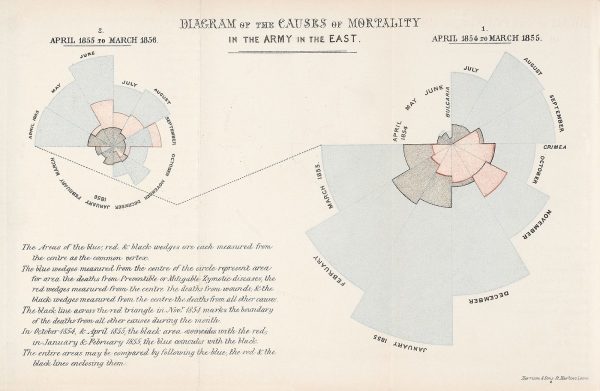

From a design standpoint, Nightingale also used effective contrasting colors, and matched those colors to fit with our previous representations red for wounds, as in blood, and blue for disease, as in sickly flesh. As mentioned in the Data Display chapter by KCR, Nightingale’s rose diagrams allowed her readers to successfully compare numbers, because each wedge was in a relative location, and because it’s generally in the simple form of a circle. Her rose diagrams were innovative in that they didn’t show parts of one, fixed whole, but rather they showed a progression of rates that mimicked real life trends in mortality. In the center, she displays what the military deaths would have been had the fighting men been healthy she surrounds this portion of the diagram with sections that show what the military death rate actually was, insinuating that this exaggerated mortality rate is largely due to the poor health conditions of military hospitals.

Her rose diagrams were effective because they were unprecedented in their design. After several proposals and months of waiting, she submitted an annex in which she included statistical information and the rose diagrams, eventually earning her fame as a nurse as well as an information designer. Her requests to restructure the state of military health care was strongly opposed by both the military and medical fields. Nightingale originally became involved in the war effort as the lead of a team of nurses sent to help create a more efficient and sanitary medical environment.

Technical Communication Quarterly, 14(2), 161 – 182.īrasseur analyzes Florence Nightingale’s invention of the rose diagram as a rhetorical appeal to raise awareness of the poor sanitary conditions in hospitals during the Crimean War. Florence Nightingale’s Visual Rhetoric in the Rose Diagrams.


 0 kommentar(er)
0 kommentar(er)
